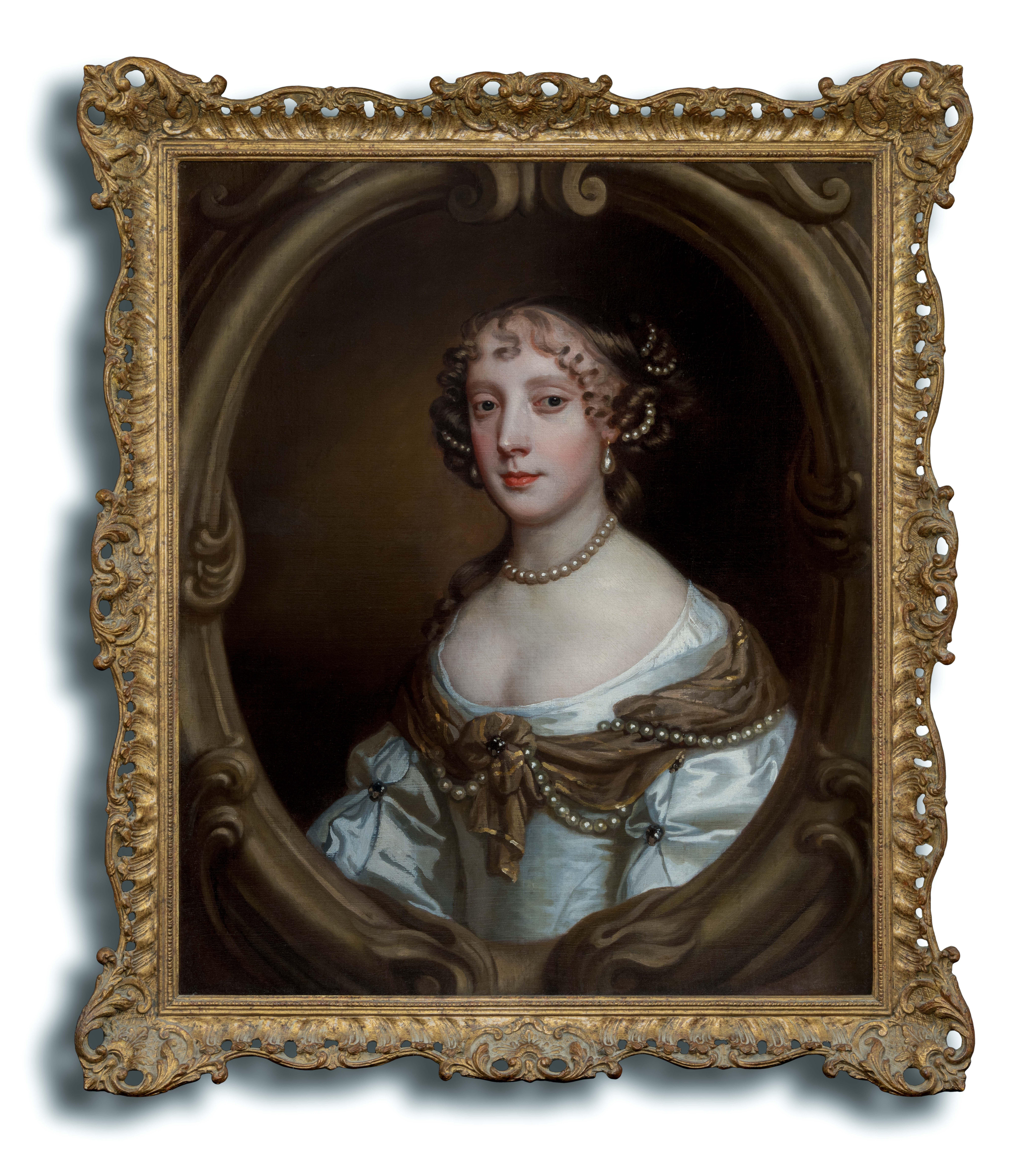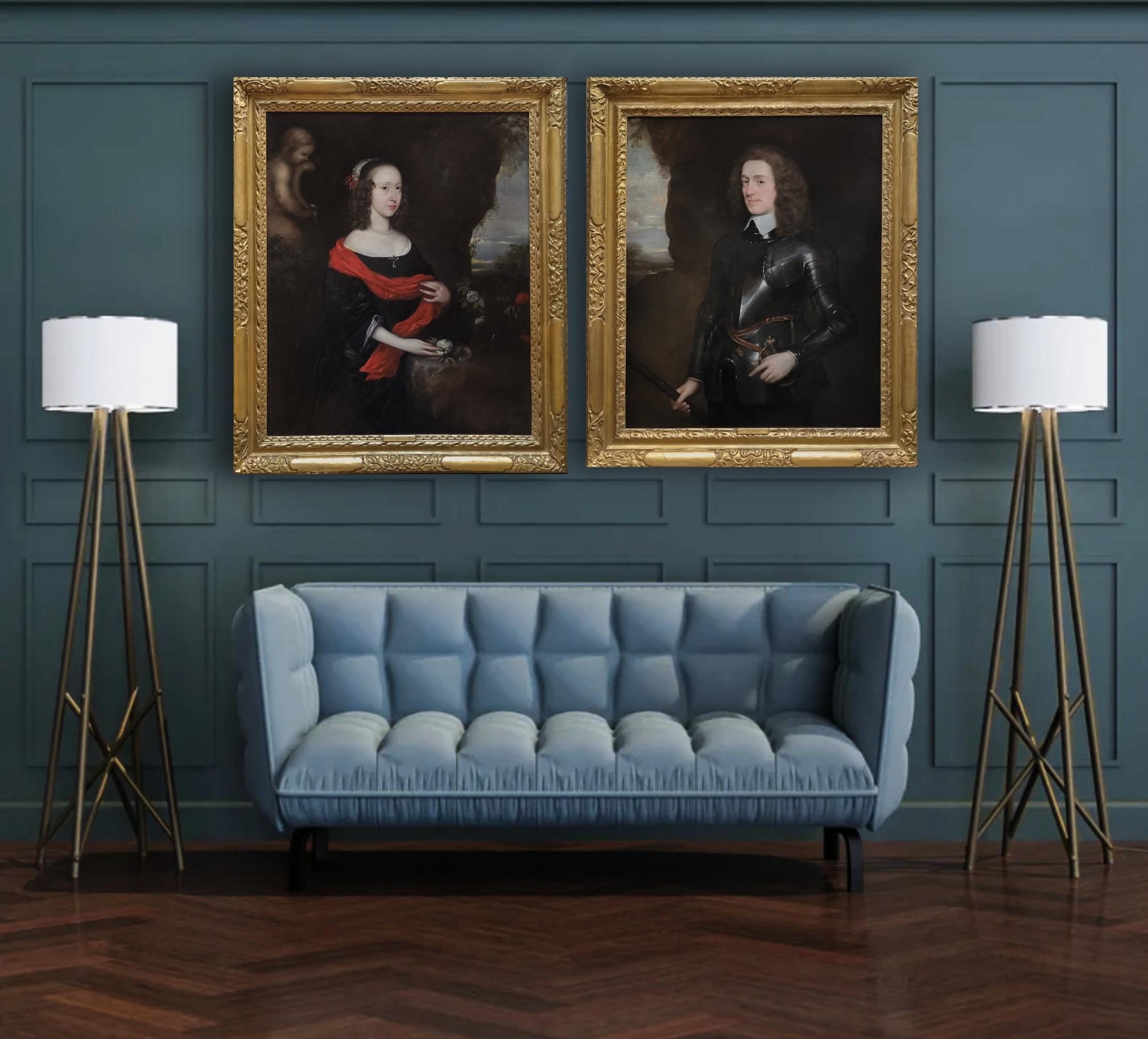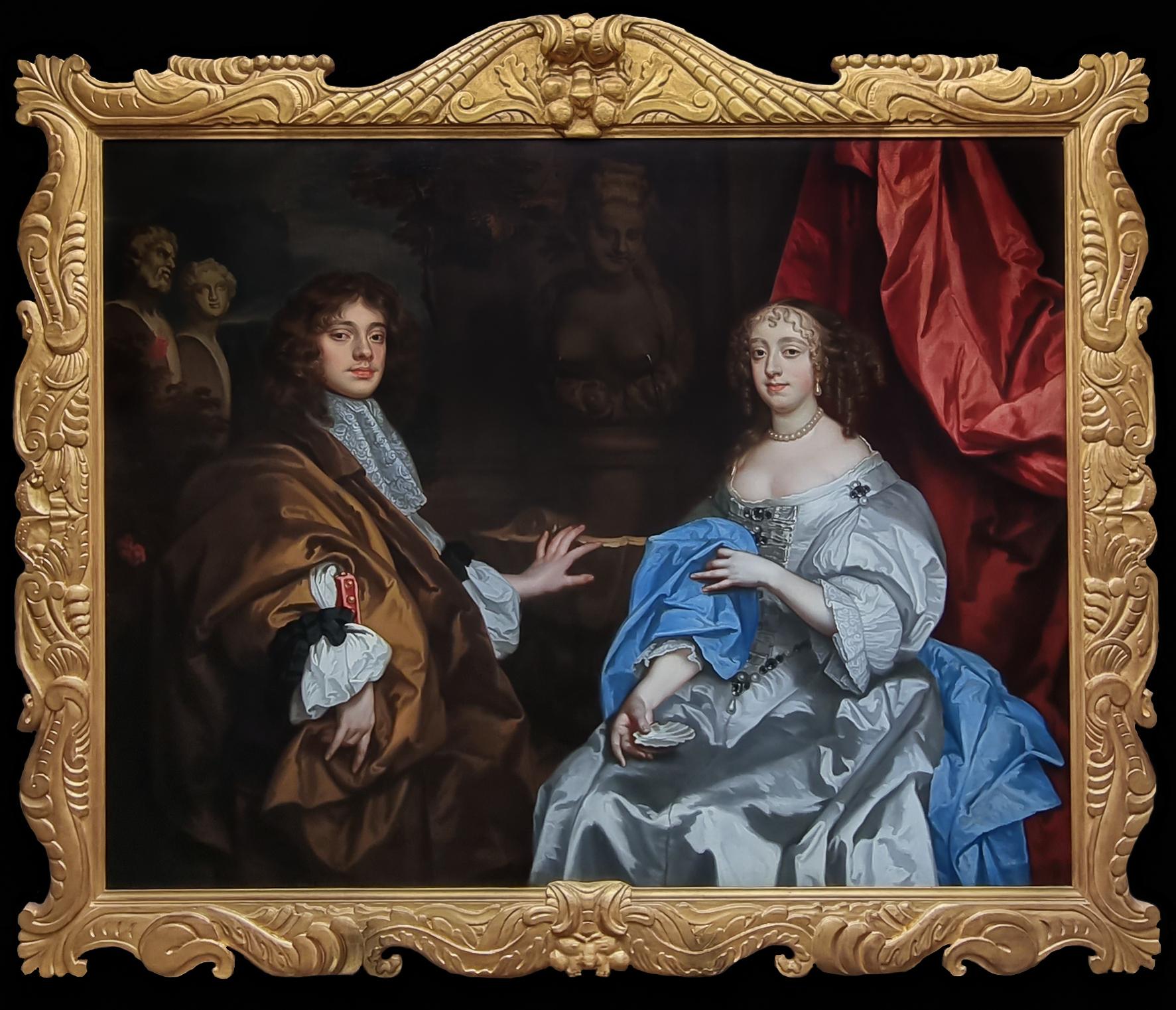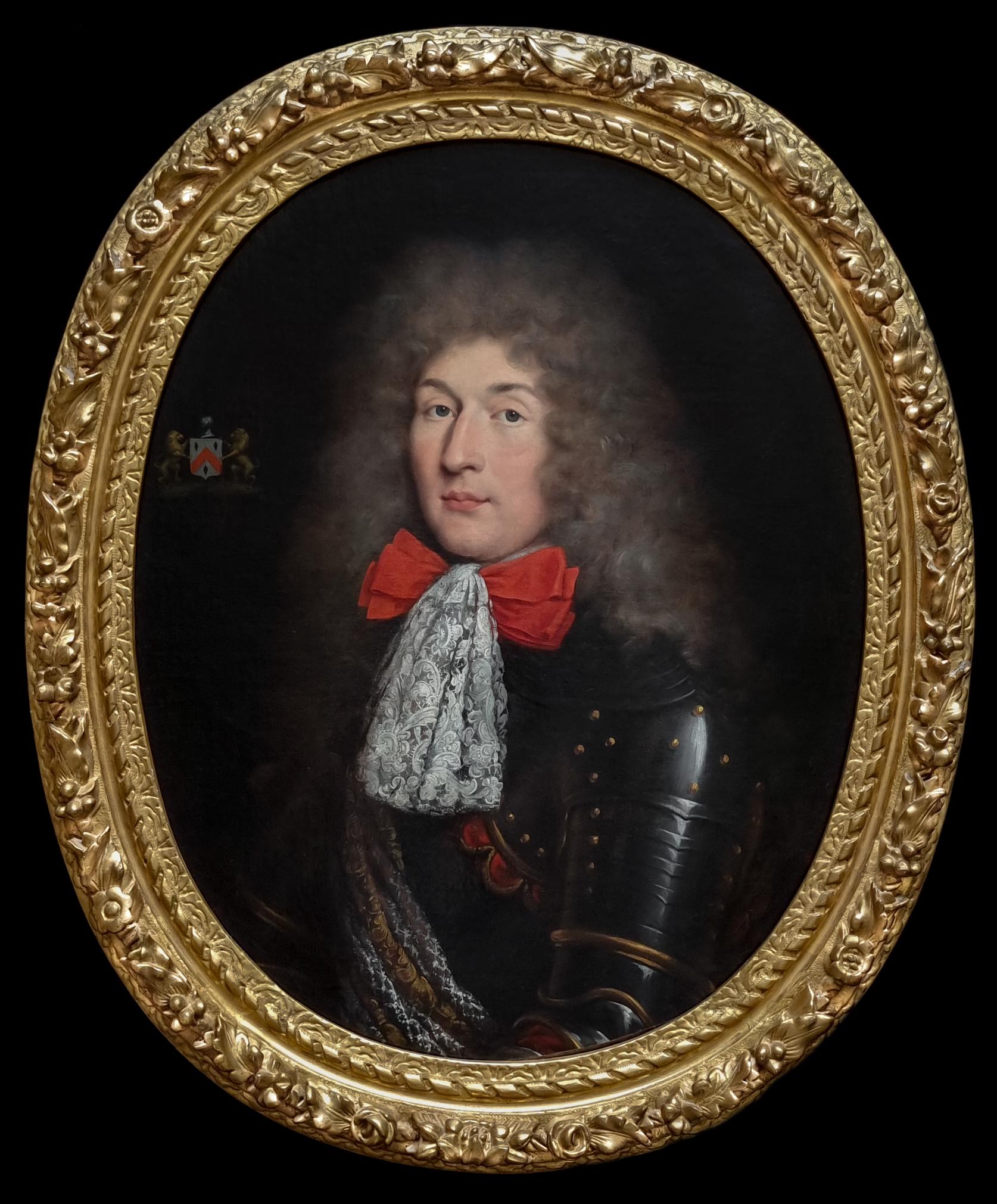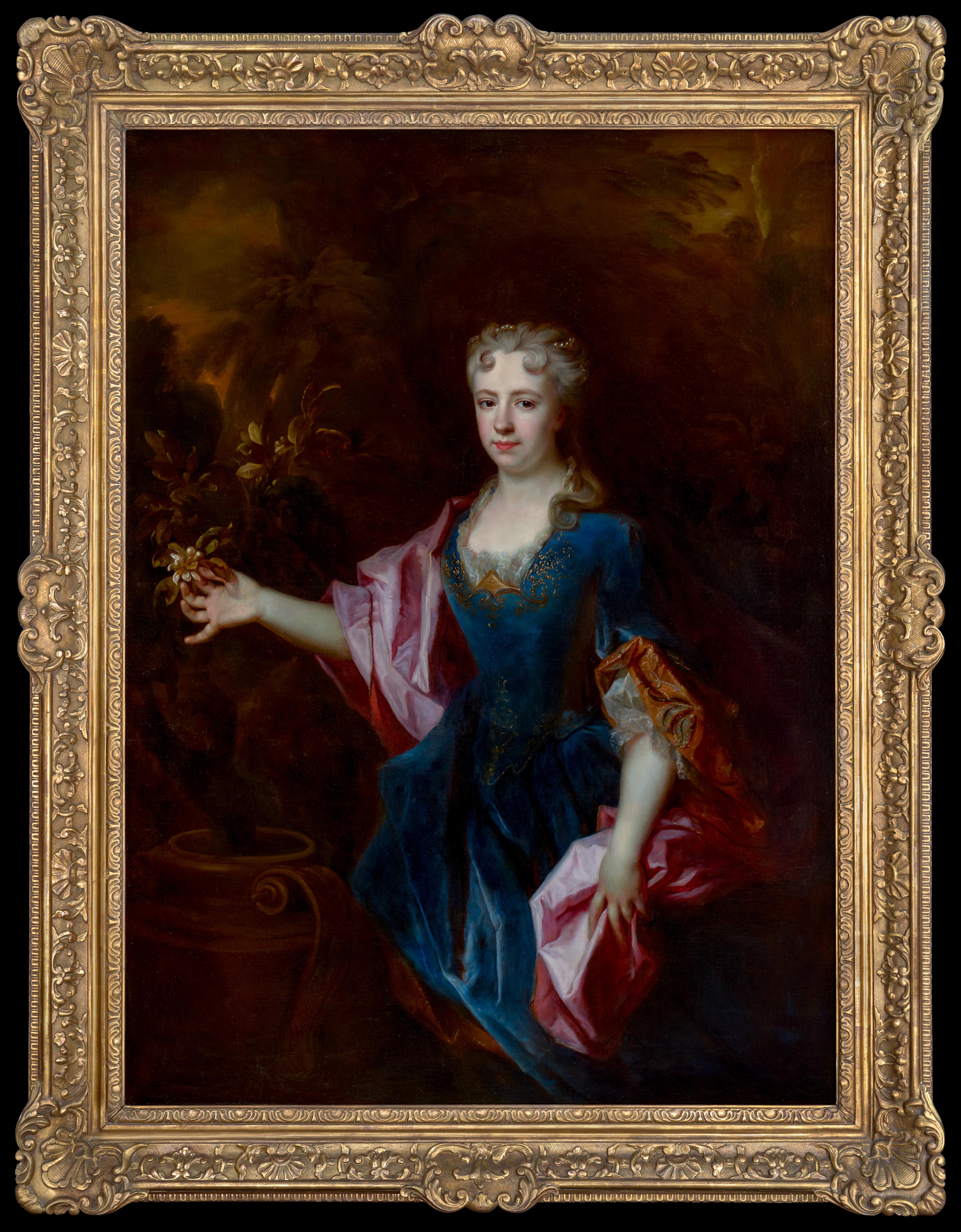Items Similar to Portrait of a Young Gentleman and Pet Dog c.1680, Antique oil on Canvas Painting
Want more images or videos?
Request additional images or videos from the seller
1 of 12
(Circle of) Mary BealePortrait of a Young Gentleman and Pet Dog c.1680, Antique oil on Canvas PaintingCirca 1680
Circa 1680
About the Item
The portrait genre was valued particularly highly in English society. Neither landscapes nor allegorical pictures were ever priced so highly at exhibitions and in the trade as depictions of people, from the highest aristocracy to scholars, writers, poets and statesmen. This charming portrait, presented by Titan Fine Art, of a fashionable young gentleman and his faithful pet is an excellent example of 17th century child portraiture in England. There is a remarkable beauty and sensitivity to the portrait. The face, particularly well rendered, has captured the character of this young man – both charming and at the same time mischievous.
Only the playful attention of a small dog suggests anything less than patrician dignity. Symbolism was important in portraiture and it provided a pointed and aspirational narrative that would not have been lost on contemporary viewers. For example, the presence of the dog, which was likely the boy’s pet, is at once a charming pictorial device and also a clear allusion to fidelity, trust and loyalty.
The hairstyle and the attire, notably the type of cravat with the blue ribbon, help to date this portrait to between 1670 to 1685. Until the late eighteenth century children were dressed as adults - boys were dressed like men in breeches, vests, and coats between four and seven years of age. The expensive lace is an indication to his family’s wealth.
Held in a good quality and condition antique gilded frame.
Born in Suffolk, Mary Beale, nee Cradock (1633-1699) was employed by many of the most distinguished persons of her time including nobility, landed gentry, and clergymen. Technically accomplished, her paintings are noteworthy for their honest and sympathetic portrayal. In 1651 she married Charles Beale, who shared her interest in art, and thus the Beale studio was a partnership between husband and wife. While Mary painted, Charles provided practical support. He primed canvases, procured art supplies from merchants, manufactured expensive, high-end pigments such as red lake and ultramarine (some for sale to other painters), and kept the books. He also left detailed notebooks about his wife’s daily activities; such as her commissioned portraits as well as the experimental studies. For the latter, he identifies the sitters and, in most cases, their poses and tracks the progress of each work from one sitting to the next, paying particular attention if a novel technique had been used. The Beale's purpose in carrying out the studies, as well as to develop skills, was to test out, various painting methods. Together they sought to improve the studio's efficiency, through perfecting procedures that would produce good results at a lower cost. These accounts of the daily activities are an incredibly valuable insight into the working practices of her studio. In fact, we know more of her technique and working practice than that of many of her contemporaries, including Sir Peter Lely.
By the late 1650s, Beale had developed a formidable reputation and befriended Sir Peter Lely, the leading artist of the Restoration and court painter to Charles II, King of England. She observed Lely in his studio—a rare privilege—and copied many of his portraits, modelling her technique after his. Lely would visit the Beale home occasionally to observe Mary paint and praise her work and Lely loaned Beale some of his old master paintings to copy from.
During her childhood in Suffolk Mary's father was friendly with contemporary British artists such as Sir Nathaniel Bacon, Robert Walker, and Sir Peter Lely, leading to both Robert Walker and Peter Lely being "the most likely drawing masters to the young Mary". Even though Beale occasionally adapted some of Lely’s poses it is not known for certain with whom she studied; Lely encouraged her in her efforts but there is no evidence that he actually instructed her. However, her father was an amateur artist and seems the most likely candidate to have shown her how to draw and paint.
She was exceedingly industrious and experimented with many new materials and techniques. She often employed the use of an elaborate stone cartouche that surrounded her sitters and by the 1670s, the couple’s two young sons Charles and Bartholomew, were assisting his mother in her painting studio in Pall Mall, executing feigned stone cartouches in head and shoulder portraits as well as painting drapery.
In 1672 she earned £202 for her commissions, and in 1677 she had 83 commissions, earning £429, a considerable sum. She also took students, many of them women, including Keaty Trioche and Sarah Curtis. All proof that Mary was earning her living and supporting her family with her art which was a highly unusual position for a woman at the time.
Provenance: The Flower family at Hill House, Stratford-upon-Avon; thence by decent
The Flower family were a prominent family in Stratford upon Avon, having established a brewery there in 1833. Edward Fordham Flower was one of the largest employers in the town, whose interests the family had very much at heart: four generations in turn became Mayor. His sons were Edgar and Charles. In the 1870's Charles Flower gave land and £1,000 to launch a fund to build the Shakespeare Memorial Theatre - and as Mayor on Shakespeare's Birthday, 23 April 1879 had the privilege of opening a beautiful High Victorian playhouse of intricate brickwork and castle features. Shortly afterwards, he initiated measures to transform the Bancroft into a pleasure garden for townsfolk - as it remains to this day.
In the 1890's his brother Edgar brought the medieval grammar school buildings back into a proper state of repair and restoration. An aunt continued the philanthropic tradition, caring not only for all of the many nieces and nephews, but also for employees and townsfolk and their children, even to the extent of purchasing numerous grave spaces at the newly opened municipal cemetery in Evesham Road, to lessen the fear of a pauper's burial.
Sir Archibald Flower, (Mayor in 1932), maintained the family theatrical involvement, and oversaw the fund-raising for the re-building of the Shakespeare Memorial Theatre, opened that same year.
- Creator:(Circle of) Mary Beale (1633 - 1699, British)
- Creation Year:Circa 1680
- Dimensions:Height: 35.44 in (90 cm)Width: 32.29 in (82 cm)Depth: 3.15 in (8 cm)
- Medium:
- Movement & Style:
- Period:
- Condition:This item has passed a strict quality and condition check by a professional conservator prior to going on sale. It can be hung and enjoyed immediately.
- Gallery Location:London, GB
- Reference Number:1stDibs: LU119919225922
About the Seller
5.0
Platinum Seller
These expertly vetted sellers are 1stDibs' most experienced sellers and are rated highest by our customers.
Established in 1998
1stDibs seller since 2019
31 sales on 1stDibs
Typical response time: <1 hour
- ShippingRetrieving quote...Ships From: London, United Kingdom
- Return PolicyA return for this item may be initiated within 14 days of delivery.
More From This SellerView All
- Portrait of Lady, Grace Saunderson, Viscountess Castleton Oil on canvas PaintingBy Studio of Sir Peter LelyLocated in London, GBPortrait of Grace Saunderson, Viscountess Castleton (1635-1667) c.1665-67 Sir Peter Lely and Studio (1618-1680) Titan Fine Art present this work, which formed part of a collection of family pictures and heirlooms of the Saunderson, Viscount Castleton family and their descendants, the Earls of Scarbrough, at their magnificent family seat Sandbeck Park, where the Earls still reside today almost four hundred years later. It was painted in the studio of Sir Peter Lely...Category
17th Century Old Masters Portrait Paintings
MaterialsCanvas, Oil
- Pair (2) Portraits Gentleman & Lady, William & Rachel Helyar c.1656, Civil WarBy Robert WalkerLocated in London, GBPortrait of Colonel William Helyar (1621-1698) and Rachel Helyar (c.1633-1678) c.1656 Circle of Robert Walker (act. 1637-1656) These fascinating portraits, presented by Titan Fine Art, depict Colonel William Helyar, High Sheriff of Somersetshire, and his wife Rachel Helyar nee Wyndham, a daughter and co-heiress of Sir Hugh Wyndham, 1st Baronet (died 1663) of Pilsden Court, Dorset. They are exquisite examples of portraiture during the Interregnum when England was under various forms of republican government. The history of the seventeenth century is in part the story of the Stewarts and their approach to government and the church; their ebbing and flowing popularity and the disastrous decisions that led to Civil War. But another fascinating dynasty also ruled Britain: the Cromwell’s. Between 1653 and 1659, following the Civil Wars and experimental Commonwealth, Oliver Cromwell governed as Lord Protector followed by his son Richard. Cromwell’s Protectorate is usually imagined as a grey, joyless, military regime. But the reality was rather different. Cromwell presided over a colourful and fashionable court where music and the arts flourished, masques were revived and the first English operas performed. Too often the London of the 1650s is painted as puritanical and repressive in contrast to the vivid, fun-loving capital of the Restoration. Yet, under Cromwell, this was the city where the first coffee houses were opening, where a young Samuel Pepys was embarking on his career as a civil servant with the patronage of one of Cromwell’s councillors and where Christopher Wren was enjoying his new Chair of astronomy at Gresham College, appointed after the personal intervention of Cromwell. When Cromwell was invested as Lord Protector for the second time in 1657, the lavish ceremony in Westminster Hall and procession through London matched any previous coronation for pageantry with thousands lining the streets, bells ringing, bonfires blazing and free French wine flowing through the city. The gentleman in our portrait is Colonel William Helyar (1621-1698), Sheriff of Somerset and as a Royalist during the English Civil War. As one of the most prominent old families of the South-West, the Helyar’s family roots in Somerset can be traced back to 1616 when the Reverend William Helyar (1559-1645), chaplain to Elizabeth I, who was also a cousin by marriage, purchased the family residence Coker Court in East Coker, Somerset. He married a Devonshire heiress and several estates were bestowed on him as a result. He was a warm supporter of Charles I in the Civil War and was in residence at Exeter in 1643 when the Parliamentarians pillaged the cathedral. Elderly as he was, he boldly resisted them, but was beaten, pelted with mud, and locked up in a ship in the port and only let out on payment of £800. He retired to Coker where he died in 1645. His eldest son Henry died in 1634 and he was succeeded by his grandson, Colonel William Helyar, the sitter in our portrait. Colonel Helyar raised a troop of horse for King Charles I and was a colonel in the king's army. He was at Exeter when it was captured by the Parliamentary forces in 1646 and thus deemed ‘Traitor to the Parliament’. His estates were sequestered, but they were returned and he was discharged and pardoned on payment of £1,522. During the Restoration he was a Sheriff and he also helped James II repel the Monmouth Rebellion. The companion portrait represents the Colonel’s wife, Rachel Helyar (baptised 24th June 1633 at St Mary Aldermanbury, London – died 1678). She was the youngest daughter and co-heir of Sir Hugh Wyndham, 1st Baronet of Pilsdon Court and Mary Wyndham nee Alanson (Sir Hugh should not be confused with his first cousin once removed from Somerset, also Sir Hugh Wyndham (bef. 1604 - 1684). Rachel is a thirteenth generation descendant of King Henry III. The couple resided at the family seat of Coker Court (interestingly, within the churchyard, lie the remains of the poet T.S. Eliot who once wrote a poem about East Coker). A marriage settlement in extant shows that the couple were married in 1656; the portraits were most likely painted to mark this important event in the sitter’s lives. Rachel holds roses, the flower of love, and the putto pouring water is representative of her purity, and possibly, the plighting of troth. Colonel Helyar wears a gold wedding band. The couple had four sons: George, William (MP) (1662-1742), John, and Richard. Colonel Helyar died in December 1697 and was buried at Whitechurch, Dorset 2 Jan 1698. This period in which this portrait was painted was known as the Protectorate (1653-1659). This period offered relative peace, as the English Civil War ended in 1651. It was an interesting time for portraiture in England and Scotland – in between the great artistic geniuses and dominance of Van Dyke and Peter Lely. Much of the foreign-born artistic talent had fled England and Scotland during the Civil War and the artists that had remained were in great demand, in part due to the newly exposed strata of society wishing to be painted. Sitters on both sides were depicted in portraits in very similar ways. They are not, on the whole, shown as the Roundheads and Cavaliers of popular history. In fact, it is usually impossible to guess their political allegiances from the style of their portrait and their Parliamentarian and royalist iconographies, as portraits on both sides followed the same conventions and looked identical. Colonel Helyar has been depicted in armour and holding a Marshal’s baton of command, confirming his status. There is a great sense of realism and a particular delicacy, note the finely rendered hand resting on the rapier. Rachel is wearing a satin dress with expansive sleeves and a crimson drapery over her shoulder and held up by her left hand. She wears large pearl...Category
17th Century Old Masters Portrait Paintings
MaterialsCanvas, Oil
- Double Portrait of Sir John Rivers 3rd Baronet of Chafford, and Lady Anne RiversLocated in London, GBThis magnificent grand-scale work, offered by Titan Fine Art, formed part of a collection of family pictures and heirlooms of the Rivers Baronets and their descendants for over 325 years, before it was dispersed by the last in the line in 1988. The work was painted by the most technically proficient painter in England after the death of Van Dyck, and the dominant court painter to Charles II and James, Duke of York, Sir Peter Lely. It is no surprise that for years Lely had no serious rivals, was enormously influential and successful, and one of the country’s most important painters – and his work influenced countless artists over generations. The exquisite carved and gilded auricular frame is an astounding work of art in itself. The sitters in this exquisite double portrait are Sir John Rivers, who succeeded as the 3rd Baronet Chafford in 1657 (c.1638 - c. 1679), and his wife, Lady Anne Hewitt (c.1640-c.1689). They are seated in an outdoor setting beside a fountain modelled as a female figure with water issuing into a scallop-shell. The water, the elaborate sculpted fountain with its scallop-edged bowl, and the open shell in her hand are symbols of fertility - as such they make an appropriate allusion to Lady Anne’s potential as wife and mother, recalling Proverbs, chapter 5, verse 18: “Let thye fountain be blessed, and rejoice in the wife of thye youth”. This reference was realised, as Sir John and Lady Anne produced at least six children; their son George (1665-1734) became 4th Baronet of Chafford. The composition, thus, represents a celebration of marriage and was likely commissioned around the time of the betrothal (the marriage took place 26th Feb 1662 or 1663). The statues in the left margin are 'Youth and 'Old Age' and are a typical form of Memento Mori reminding virile young man that even they will lose their youth and grow old. The Rivers family, originally of Kent, traces its history to Sir Bartholomew Rivers, in the reign of Edward IV. The family included several prominent members including several knights, a Commander in the King's Army, a steward of a ducal estate, a Lord-Mayor of London, and an M.P. John Rivers (c.1659-c.1651) was made 1st Baronet of Chafford in 1622 by King James I. The Chafford estate was the family seat and it remained so until the early 1700s with the death of Sir George Rivers, 4th Baronet (1665–1734), whose sons had all died. The Chafford estate was left to his daughters while the baronetcy passed to nephew John Rivers, 5th Baronet (c. 1718–1743), and then Sir John’s brother, Sir Peter Rivers-Gay, 6th Baronet (c. 1721–1790). Upon Sir Peter Rivers Gay's death the estate passed to his eldest son, Sir Thomas Rivers Gay, 7th Baronet (c. 1770–1805). Sir Thomas, dying in 1805 with no children, bequeathed the estate to his mother Dame Martha Rivers Gay, who managed the estate until 1834 when she settled it on the then Sir Henry Rivers, 9th Baronet (c. 1779–1851) her younger son, before dying shortly thereafter in 1835. Sir Henry had married in 1812 to Charlotte Eales, with whom he had 6 sons and 8 daughters. Upon his death in 1851 the estate passed to his eldest surviving son Sir James Francis Rivers, 10th Baronet (1822–1869). Sir James married Catherine Eastcott in 1867 but died childless in 1869, and the estate passed to his only surviving brother Sir Henry Chandos Rivers, 11th Baronet (1834–1870) but he died a year later in 1870 also childless; with no male heir the Baronetcy was therefore extinguished. The estate was bequeathed, in trust, by Sir Henry Chandos Rivers to Thomas Frederick Inman, a solicitor of Bath, who then managed the estate as a trustee on behalf of Sir Henry Chandos Rivers' sister Katherine Rivers (c.1826-1895). It then passed to Katherine River’s daughter, Katherine Wall (born c.1855), who had also inherited Worthy Park House from her father, George Alfred Ellis Wall (1825-1875). Until 1958 our portrait is known to have hung at Worthy Park House. Upon Katherine Wall’s death, the Rivers estate passed to her daughter, Katherine Eleonora Rivers Fryer (1889-1963), who married Colonel James Alexander Butchart 1877-1853. In 1958 the family sold Worthy Park House but our portrait was loaned to Southampton Museum and Art Gallery. After the death of Katherine and Colonel James, the estate was left to their only son, Charles Bruce Rivers Butchart (1917-2005) and upon Charles’ retirement to a nursing home in 1988, and without heirs, our portrait, along with the residual assets of the Rivers estate were sold, thus ending over 325 years of continual family ownership. Lady Anne Rivers is thought to have been born circa 1640. She was the fourth child of the second marriage of Sir Thomas Hewitt (or Hewett) (1606-1662), 1st Baronet of Pishobury, Herts, and his wife Margaret Lytton (died 1689). Sir Thomas was an English landowner and M.P. for Windsor and upon the English Restoration...Category
17th Century Old Masters Portrait Paintings
MaterialsCanvas, Oil
- Portrait Lady in Red Silk Dress c.1710, Michael Dahl, oil on canvas paintingBy (Circle of) Michael DahlLocated in London, GBThis charming work is a good example of the type of portrait in vogue during the first quarter of the eighteenth century in Britain. The sitter, portrayed bust-length, wears a russet silk dress over a white chemise...Category
18th Century Old Masters Portrait Paintings
MaterialsCanvas, Oil
- Portrait of Gentleman in Lace Cravat & Armour 1680’s Painting, Fine Carved FrameBy (circle of) Pierre MignardLocated in London, GBTitan Fine Art presents this portrait of a brave and chivalrous character. The gentleman has been depicted in armour, an elaborate full wig, and in accordance with the latest French fashion, an elaborate type of Venetian Gros point lace cravat and large silk bow (also called a cravat-string) – a type that were popular across Europe in the 1680’s. Point lace was fabulously expensive - a cravat was equivalent to six weeks income for a gentleman - and therefore indicative of a wearer's wealth and social class. A nobleman riding onto the battlefield would wear a lace cravat over his armour to demonstrate his status. The attire, along with the coat-of-arms, help to proclaim to every onlooker that the gentleman is a superior being. The depiction of the lace, apart from denoting the wealth of the sitter, was a deliberate way for the artist to demonstrate his own artistic ambition and technical skills Argent seasoned gule with three lozenges sable are those of the Crois family, who were minor nobility, originating from the Boulogne region in the north of France. The fact that the sitter is a high ranking noble excludes him as a member of the Crois family. As is so commonly the case, the coat of arms was a later addition, probably in the nineteenth century, by a family who sought to glorify their pedigree by adding their arms to the portrait. These arms are now an interesting part of the portraits history. The artist has captured a sense of the sitter’s character and the features of the sitter’s face have been rendered with great sensitivity. His confident gaze perhaps reflecting the near invincibility afforded by this steel suit. The work is a very good example of French portraiture from the period. Presented in an exquisite hand-carved and gilded seventeenth century frame - which is an exceptional work of art in itself. Pierre Mignard, known as le Romain, was a French painter of the court of the French King Louis XIV and was, with Charles Le Brun (1619-90), one of the most successful painters during the reign of Louis XIV. After training in Troyes, where he was born, and in Bourges, Mignard joined the studio of Simon Vouet in Paris in 1627. He went to Italy in 1636 and remained there until 1657. He studied the work of Correggio and Pietro da Cortona in Rome as well as copying Annibale Carracci's frescoes in the Palazzo Farnese. On Le Brun's death in 1690 he succeeded him as its Director and as First Painter to the King painting...Category
17th Century Old Masters Portrait Paintings
MaterialsOil, Canvas
- Portrait of a Lady, Marie-Madeleine de Chamillart, Oil on Canvas PaintingLocated in London, GBThis work, offered by Titan Fine Art, formed part of the collection of paintings and family heirlooms of Baron Hugues Alfred Frèdéric de Cabrol de Moute (1909-1997) and his wife, Baroness Marguerite (née d’Harcourt) de Cabrol de Moute (1915-2011). The couple had unimpeachable and enviable family backgrounds, and were descendants of ancient princelings; together they were one of the most prominent high-society couples of the twentieth century and counted the Duke of Duchess of Windsor amongst their closest friends. This portrait is that of Marie-Madeleine de Chamillart (died 28 May 1751) nee Nicolas de Lusse. She had a daughter, Anne, in 1692. In 1700 she married Clément Chamillart (1663-1708), President of the Accounts of the King's Chamber. The couple had a daughter, Madeleine (born 1701), who married Louis, the only son of Guillaume de Guitaut and Antoinette de Vertamont in 1719. Guillaume de Guitaut resided at Château d'Époisses in Burgundy France and his descendants still live today. A portrait of our sitter is still held at the Château. Clément Chamillart died in 1708 and our sitter remarried Jean-Baptiste de Johanne de la Carre (1678-1726), marquis de Saumery, maréchal de camp, in 1713. This marriage produced two daughters, Marguerite (died 1729) and Marie Madeleine (born 1720). Much of the beauty of this elegant portrait resides in its graceful composition – it is a fine example of French portraiture. Beautifully and meticulously rendered throughout, the sitter has been depicted three quarter length in an outdoor setting beside a potted orange tree. The lady is shown in a blue dress with silver detailed décolletage and large voluminous sleeves turned over to reveal elaborately detailed lining. The sumptuous fabrics convey a sense of wealth and prestige. The portrait is striking in its portrayal of the sumptuous fabrics and their decorative richness. The prominent sprig of orange blossom that she is holding is a traditional representation of marriage and eternal love in art, but it also alludes to youth and freshness, and by virtue of the great expense and difficulty with which it was often grown, to great wealth. In accordance with the sitter's age and the style of clothing and hair with the curls on the forehead, this portrait can be dated to the 1720s. Baron Hugues Alfred Frèdéric de Cabrol de Moute (1909-1997) was the son of Roger de Cabrol de Moute and Helen Mary de Lassence. He was one of the more engaging personages in that delightful social constellation of social figures who animated what has become known as "Cafe Society" which was international but inevitably most at home in Paris from the 1920's until the 1960's. He married Marguerite d'Harcourt (1915-2011), known as Daisy, in Paris in 1937, the only daughter of Étienne, Marquis d'Harcourt, and his wife, Marie de Curel. The Harcourt family belongs to the circle of the oldest families in France; the founder of the family, Bernard le Danois, received the seigniory of Harcourt in the tenth century, following the conquest of Normandy. In the 11th century, his descendants took part in the conquest of England alongside William the Conqueror. Later, the Harcourt family was divided into a French branch and an English branch, which successively received the titles of barons, viscounts, and counts. Marguerite "Daisy" Marie Brigitte Emmanuelle Ghislaine d'Harcourt, Baronne de Cabrol was one of the last survivors of twentieth century French high society. Through her mother, Daisy was a descendant of the great industrial family of Wendel, with iron and steel enterprises in Lorraine; she also descended from Nicolas Soult, one of Napoleon's Marshals and three times Prime Minister of France. The couple became friends of the Duke and Duchess of Windsor in 1947, and were invited to the Chateau de la Croë, their rented house on Cap d'Antibes. There they found the exiled Windsors living in unusual post-war luxury, serving delicious food and providing fresh sheets every day. Daisy suspected that the Windsors were bored, but, having nothing else to do, were condemned to an endless round of social engagements. She and Fred were among the few allowed to see the Duchess laid out after her death in 1986. Daisy was a considerable hostess, giving a ball every year for her charity, L'Essor, to which le tout Paris would come. One of these, in 1954, was at the Palais des Glaces, in Paris (later used in the film Gigi), at which she entertained Charlie Chaplin, the Begum Aga Khan and the Windsors. According to Nancy Mitford...Category
18th Century Old Masters Portrait Paintings
MaterialsOil, Canvas
You May Also Like
- 17th century Dutch portrait of a Lady in Red adorned with PearlsBy Pieter NasonLocated in Bath, SomersetPortrait of a lady, half-length in a feigned oval wearing a ruby coloured silk gown holding entwined strings of pearls across her bodice. Signed 'PNason' and dated 1667 (lower right)...Category
17th Century Old Masters Portrait Paintings
MaterialsOil, Canvas
- 16th Century By Circle of Giovan Battista Moroni Portrait of Woman Oil on CanvasLocated in Milano, LombardiaGiovan Battista Moroni (circle of) (Albino, 1520 – 1580 ca.) Portrait of a woman Oil on canvas, cm. 46 x 40 - with frame cm. 55,5 x 50,5 Antique shaped and gilded wooden cassetta frame. Publications: unpublished. The present portrait shows an adult woman, no longer young, as can be seen from her slightly blistered cheeks, but not elderly either. The suspicious and veiledly inquisitive gaze is well matched by the elegance of her extremely fashionable black clothes...Category
16th Century Old Masters Portrait Paintings
MaterialsCanvas, Cotton Canvas, Oil
- 17th century portrait of lady in an ivory silk gown and lace collarBy Cornelius JohnsonLocated in Bath, SomersetCircle of Cornelius Johnson (1593-1661), a 17th century portrait of a lady, bust-length oval, wearing an ivory silk gown with blue silk bows and lace c...Category
Early 17th Century Old Masters Portrait Paintings
MaterialsOil, Canvas
- 17th Century by Juan Alfonso Abril Head of St Paul Painting Oil on CanvasLocated in Milano, LombardiaJuan Alfonso Abril (active in the 17th century in Valladolid) Head of Saint Paul Oil on canvas, cm. 48,5 x 62 - with frame cm. 63 x 76,5 Shaped wooden f...Category
Early 17th Century Old Masters Figurative Paintings
MaterialsCanvas, Oil
- 17th Century portrait oil painting of a gentlemanBy Willem WissingLocated in Nr Broadway, WorcestershireCircle of Willem Wissing Dutch, (1656-1687) Portrait of a Gentleman Oil on canvas Image size: 29 inches x 24.5 inches Size including frame: 35 inches x...Category
17th Century Old Masters Portrait Paintings
MaterialsOil, Canvas
- 18th Century portrait oil painting of a boyBy Robert ByngLocated in Nr Broadway, WorcestershireCircle of Robert Byng British, (1666-1720) Portrait of a Boy Oil on canvas Image size: 28.5 inches x 23.5 inches Size including frame: 34.5 inches x 29.5 inches A fine half-length ...Category
18th Century Old Masters Portrait Paintings
MaterialsOil, Canvas
Recently Viewed
View AllMore Ways To Browse
House Of Antiques
The House Of Antiques
Century Of Progress
Son Of Man
Son Of A Man
House Of Art Dress
Portrait Poet
Antiques On Sale
Circle Of Women
Antique Paintings Of Flowers
Study Of Young Child
End Of The Road
Antique Dog Painting Paintings
Mary King
Gilded Age Paintings
Portraits Of Boys
Dog Flower
Old Man Face
